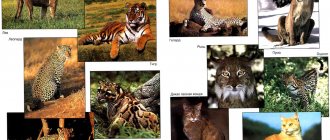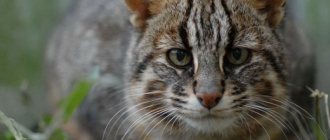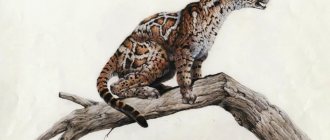The tiger is a species of predatory mammal from the cat family, belongs to the genus Panther, a subfamily of big cats. These are the largest representatives of wild cats, and the Amur and Bengal tigers are second in size only to the polar and brown bear. All tigers are characterized by a strong, elongated body with a more developed front part, a long tail, and the ability to retract their claws. They have acute vision, including night vision, and good hearing. Tigers of all subspecies have large fangs.
Malayan tiger
The 250-340 surviving Malayan tigers (Panthera tigris jacksoni), the national animal of Malaya, have been listed as critically endangered by the International Union for Conservation of Nature (IUCN). These animals are found in the forests of the Malay Peninsula. They are smaller in size than Indian tigers.
They hunt a wide variety of game: deer, wild boar, calves, elephants, rhinoceroses and bears. Persecution from their habitats and constant raids by poachers, who caught and killed tigers for the preparation of traditional Chinese medicines, as well as for decorative purposes, led to a steady and sharp decline in the number of this subspecies.
A group of non-governmental organizations, including the World Wildlife Fund (WWF), the Southeast Asia Movement, the Malaysian Nature Society and others, have formed an alliance with the Malayan Tiger Conservation Union to save the animals from extinction.
Other members of the cat family
Steppe cat
It slowly approaches and attacks, pouncing on the victim as soon as it is within reach (about a meter). Active at night and at dusk.
grass cat
Color varies from grayish yellow and yellowish white to brown, taupe, light gray and silver gray.
Andean cat
They do not live in captivity. All Andean mountain cats in zoos have died. Fewer than 2,500 specimens are thought to exist in the wild.
Geoffroy's cat
Gray or brown with black markings, 90 cm long, of which the tail is 40 cm. Breeds once a year, litters consist of 2-3 kittens.
Chilean cat
The base color of the coat ranges from gray and reddish to bright brown or dark brown, with small rounded black spots.
Long-tailed cat
Lives in forests, is nocturnal, feeds on birds, frogs and insects. Claws and paws allow you to move through trees and along branches.
Far Eastern forest cat
The coat is usually yellowish or reddish-brown above, white below, and heavily marked with dark spots and streaks.
Oncilla
Lives in mountainous, subtropical forests and semi-arid areas. The oncilla was hunted for its beautiful fur in the second half of the 20th century.
Ocylot
The short, smooth fur is decorated with elongated spots with black edges, they are arranged in the form of chains. The upperparts are light or yellowish-brown to gray.
Pampas cat (bell)
About 60 cm long, including a 30 cm tail. The longhaired fur is grayish with brown markings, which are fuzzy in some cats.
Serval
A slender cat with a long neck, small head and large, slightly cupped ears. Adults range from 80 to 100 cm in length, with the tail accounting for another 20–30 cm.
Canada lynx
She has a short tail, long paws, wide toes, and ear tufts raised high. The fur is light gray, the belly is brownish, the ears and tip of the tail are black.
Common lynx
Considered to be a secretive creature. The sounds it makes are quiet and inaudible; the lynx remains unnoticed by foresters for many years!
Iberian lynx
The basis of the diet is rabbit. During the winter months, when the rabbit population is low, it preys on deer, fallow deer, mouflon and ducks.
Red Lynx
About 2 times the size of a domestic cat. Thick short hair perfectly camouflages among trees under the glare of the sun.
Manul
The broad head with high-set eyes and low-set ears squeezes into rocky outcroppings where rodents and birds live.
Marble cat
Best articles: Moloch - a spiny lizard from the sandy deserts of Australia
The coat is long, soft, pale brown to brownish-gray in color, with large spots with dark edges on the body and small dark spots on the legs and tail.
Bengal cat
Nothing escapes her attention. The cat enjoys playing games and learns tricks. Hunts aquarium and pond fish if he lives in the house.
Iriomotean cat
It is found in subtropical forests on the island of Iriomote, preferring areas near rivers, forest edges and places with low humidity.
Sumatran cat
Adapted for aquatic hunting: long muzzle, flattened upper part of the skull and unusually small ears, large and close-set eyes.
Spotted ginger cat
One of the smallest cat species in the world, about half the size of a domestic cat. This animal is rarely seen in nature.
Fishing cat
The coat is pale gray to dark brown, with dark spots and streaks. Lives near water in jungles, reed beds and swamps.
Puma
Lives among desert scrub, chaparral, swamps and forests, avoiding agricultural areas, plains and other places without shelter.
Jaguarundi
Smooth long body with small ears, short legs and a long tail. Length from 90 to 130 cm, including tail from 30 to 60 cm.
Due to differences in habitat, size and color are difficult to determine. The animals in northern Iran are some of the largest leopards in the world.
Adapted to cold weather, thick fur reaches 7.5 cm in length in winter. For camouflage in the snow, their coat is paler than that of other subspecies.
Each cheetah has its own dot pattern on its body. Experts use photographs taken by camera traps to identify animals by their unique spots.
Indochinese tiger
The Indochinese tiger (Panthera tigris corbetti) is endangered. It lives in the Indochina region of Southeast Asia. A hundred years ago, no one could have thought that this particular animal would be on the verge of extinction. Today, only 600-650 individuals remain. They are already extinct in China, Cambodia and Laos.
There are only 20 individuals left in Vietnam, 85 in Myanmar and about several hundred in Thailand. These tigers have distinctive personalities, and their obscure lifestyle makes detailed behavioral studies difficult. They hunt medium and large ungulates in the forest.
Like Malayan tigers, Indochinese tigers are also threatened by poachers, who mercilessly hunt them for their skin, internal organs to prepare traditional medicines, and other things.
The situation of the subspecies today
Today, there are occasional reports of sightings of several tigers in the eastern part of the island, where about 30% of the area consists of virgin forest. It is possible that all the tigers encountered by eyewitnesses are actually leopards, which from a distance can be confused with tigers. But some cases allow us to refute this assumption.
In 2008, the body of a woman was discovered in Merbabu National Park. It was determined that the cause of death was a tiger attack. In addition, the villagers who discovered the corpse claim that they saw a tiger.
Another meeting with this predator occurred in eastern Java, in Magetan Regency, this took place in 2009. Villagers discovered a tigress with 2 cubs passing by their village.
On the island of Java, the Meru Betiri National Park was created specifically to search for possible surviving individuals of Javan tigers in the region. But today the existence of this park is threatened because gold has been found on its territory, and 3 large gold mining companies are fighting for this territory.
Bengal tiger
The Royal Bengal Tiger (Panthera tigris tigris) is the only tiger subspecies whose numbers increased from 1,706 in 2010 to 2,226 in 2014. This animal is the national animal of India and Bangladesh.
In India, the tiger ranges from the Himalayan foothills in the north to the Western Ghats landscape in the south, including the floodplain forests of the Ganges and Bhramaputra river systems, the mangrove forests of the Sundarbans, the forests of West Bengal, the Eastern Ghats landscape and the central Indian highland forests.
Small flocks are also found in Nepal, Bhutan and Bangladesh. The destruction of tigers and poaching are the main reasons for the extinction of the subspecies.
External differences
Sketch of two Transcaucasian tigers
This subspecies was distinguished by its bright red coat color, as well as the length of its stripes - they were longer and had a brownish tint. In winter, the fur of this subspecies became thicker and fluffier, especially on the belly, and lush sideburns also appeared in winter. The Transcaucasian tiger was quite large in size, approximately like the Amur subspecies, but somewhat inferior to the Bengal subspecies (modern research). The reliably known mass of a large Transcaucasian tiger is 240 kg, but due to the special secrecy of this subspecies, it can be assumed that there may have been larger specimens. The habitats of this predator were reed (reed) thickets along the banks of rivers, which in Central Asia are called tugai. The food for this subspecies of tigers was mainly goitered gazelles, saigas, kulans, roe deer and wild boars. There is evidence that the Transcaucasian tiger followed migrating wild boars as far as Eastern Kazakhstan and Altai. In the north, the upper limit of their permanent range was Lake Balkhash in Kazakhstan. In the past, it was probably also found in the Ciscaucasia, but was exterminated there long ago.
This subspecies was also distributed in the humid subtropical forests of Northern Iran and in river valleys in Afghanistan. As a rule, Transcaucasian tigers set up their rookeries in impassable places, but always close to water sources.
In Central Asia, the tiger was called “julbars”, “dzholbars”, “yulbars”. In the Turkic dialects “jol”, “jul”, “yul” means “way”, (or striped leopard from the word “yul-yul” striped) so this word can be translated as “stray leopard” or (striped leopard). The etymology of the word is related to the behavioral characteristics of the predator - it was capable of traveling hundreds and thousands of kilometers from its original location, and this tiger could travel up to one hundred kilometers in a day.
In the thirties of the 20th century, tigers were found on the banks of the Amu Darya in the Tigrovaya Balka nature reserve in Tajikistan, near the border with Afghanistan. The last documented sightings of tigers in Soviet Central Asia were recorded in the late forties and early 1950s. The last tiger to appear on Soviet territory - on the border with Iran, in Kopetdag (Turkmenistan) - came here from the northern regions of Iran.
Best articles: TOP 7 representatives of the animal world of Siberia - characteristics, photos and videos
Amur tiger
Amur or Siberian tigers (Panthera tigris altaica) of the Far East (Russia) live in two main areas of the country: the Sikhote-Alin Mountains and the Primorsky Province. According to information from the Maritime Province, since 2005 there has been a slight recovery in the number of animals from 331-393 to 480-540 in 2015.
Amur tigers are well adapted to cold Siberian winters and covering long distances of up to 1000 km. They hunt musk deer, roe deer, elk, pig, black and brown bears and even small hares and fish. At the beginning of the twentieth century, a large number of Amur tigers were eradicated from their habitat due to wars and army occupation.
Hunting them remained legal until 1947. Currently, the government is taking strict measures to conserve Siberian tigers and, based on the latest census, there are already small positive results.
Reproduction
Tigers are polygamous animals. Their mating season is December-January. At this time, males often fight for females. Since the tigress is capable of fertilization only a few days a year, mating occurs at this time many times. The first offspring of females is observed at the age of 3-4 years. A tigress usually gives birth once every 2-3 years. The duration of pregnancy is 97-112 days.
Mating season of tigers
To breed offspring, the female makes a den in a hard-to-reach place: in crevices among stones, in a cave, in a windfall. Tiger cubs are born in March-April, there are 2-4 of them, they are blind, helpless, weigh 1.3-1.5 kg, their eyes open after 6-8 days. Breastfeeding lasts for the first 6 weeks. Only the female takes care of them, and does not allow males near them. At 8 weeks, the cubs leave the den and follow their mother. They begin to live independently at 18 months, but can remain with the female until they reach sexual maturity.
Two tiger cubs together in the grass
Females become sexually mature at 3-4 years, males at 4-5 years. During her life, a female gives birth to 10-20 tiger cubs, but half die at a young age. In the wild, tigers live about 25 years.
Sumatran tiger
Forest clearance for palm oil plantations and poaching are two of the main factors leading to the rapid decline of Sumatran tiger (Panthera tigris sumatrae) populations. These animals were only discovered on the island of Sumatra in Indonesia.
The number of individuals today is believed to range from 441 to 679. Wild pigs, pheasants, porcupines and sambars are the main prey of these tigers.
Cape Lion
The Caspian lion has a precarious position in the big cat classification. Some naturalists argue that these lions should not be classified as a separate subspecies, considering the Kaispi lion to be simply a geographical offshoot of the still extant Transvaal lion. In fact, it is very difficult to distinguish a single subspecies from an isolated population. In any case, the last examples of these representatives of big cats became extinct at the end of the 19th century.
Chinese tiger
Although considered critically endangered, the South China tiger (Panthera tigris amoyensis) is in fact already an extinct species, as no sightings of these tigers in the wild have been reported for almost 25 years. These animals were once common in the forests of southern China, but habitat degradation and fragmentation, as well as high rates of poaching, have led to a rapid decline in their numbers in the country.
Today, a small number of tigers are found in captivity in zoos in China and some other countries around the world. Plans to “recreate” the number of captive Chinese tigers brought into Chinese reserves are already being developed by conservation organizations.
Description of the species
The Amur tiger belongs to the class of mammals. In fact, it is one of the largest representatives of predators on the planet, because its mass can reach up to 300 kilograms. Moreover, according to some data, during the period of their large population there were animals of this species that weighed almost 400 kg. It goes without saying that you won’t find such people anymore.
The physical capabilities of this type of predator are also impressive - a tiger can easily carry prey weighing half a ton. The speed of movement can reach up to 80 km/h, and in this indicator it is second only to the cheetah.
One cannot fail to note the appearance of this animal. Like other predators of this class, it is characterized by a color in the form of a red background and white transverse stripes. It should be noted that in this case, this color also plays a camouflage role - in order to get prey, the tiger needs to get extremely close to it, and this is where this color helps, since it simply blends in with the dry vegetation.
European lion
An interesting fact is that paleontologists classify the European lion as three subspecies: Panthera leo europaea, Panthera leo tartarica and Panthera leo fossilis. They are united by relatively large body sizes (some males weighed about 200 kg, females were slightly smaller) and susceptibility to encroachment and seizure of territories by representatives of early European civilization: for example, European lions often participated in gladiatorial fights in the arenas of ancient Rome.











